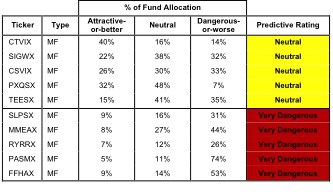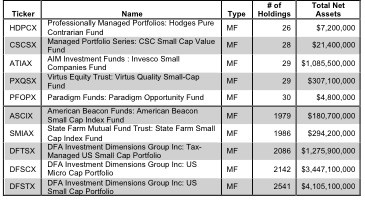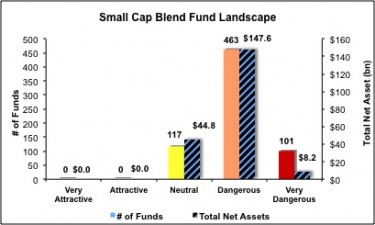The small-cap blend style ranks eleventh out of the twelve fund styles as detailed in my style roadmap. It gets my Dangerous rating, which is based on aggregation of fund ratings of 681 small-cap blend funds as of Feb 14th 2012. Articles on the funds in each sector and style are here.
Per Figure 1, none of the 681 small-cap growth funds are worth buying. In fact, 83% of the funds should be sold because they get my Dangerous-or-worse rating. Poor portfolio management drives the poor fund ratings. 2231 of the 2640 stocks (over 80% of the market cap) held by small-cap blend funds earn a Neutral-or-worse rating. The takeaway is: fund managers allocate too much capital to low-quality stocks.
Investors seeking exposure to small-cap blend stocks should buy a basket of Attractive-or-better rated stocks and avoid paying undeserved fund fees. Active management has a long history of not paying off.
As detailed in “Cheap Funds Dupe Investors”, the fund industry offers many cheap funds but very few funds with high-quality stocks, or with what I call good portfolio management.
Figure 1: Small-cap Blend Style Landscape For Funds & Stocks
The 681 small-cap blend funds are very different. Per Figure 2, the number of holding varies widely (from 26 to 2541), which creates drastically different investment implications and ratings. Review my full list of ratings along with free reports on all 681 small-cap blend funds.
How do investors pick the fund that will most likely deliver the best future returns?
To identify the best funds within a given category, investors need a predictive rating based on analysis of the underlying quality of stocks in each fund. See Figure 3.
My predictive fund ratings are based on aggregating (1) my stock ratings on each of the fund’s holdings and (2) all of the fund’s expenses. Investors should not rely on backward-looking research of past performance.
Figure 3 shows the five best and worst-rated funds for the style. The best funds allocate more value to Attractive-or-better-rated stocks than the worst funds and vice versa. The worst funds offer poor portfolio management and charge high total annual costs. My ratings and reports (updated daily) on all funds in this style are here.
Figure 3: Funds with the Best & Worst Ratings – Top 5

Sources: New Constructs, LLC and company filings
My top-rated small-cap blend fund is Mutual Fund Series Trust: Catalyst Value Fund [s: CTVIX], which gets my Neutral rating. One of its largest holdings and part of the 40% allocated to Attractive-or-better stocks is USA Mobility, Inc. [s: USMO], which gets my Very Attractive rating. Unlike a majority of the Telecom stocks, USA Mobility is a value creator, not destroyer. Details on Telecom sector funds are here.
The company has had a positive and increasing ROIC in each of the past 5 years, with a top-quintile ROIC of 16% during 2010. USMO is one of the few Telecom stocks creating value.
Despite strong economic earnings growth, its current price of ~$14.91/share implies its after-tax cash flows (NOPAT) will permanently decrease by 60%. If the company’s NOPAT just remains flat (no-growth scenario) forever, the stock is worth over $30.
My worst-rated small-cap blend fund is Forward Funds: Forward Small Cap Equity Fund [s: FFHAX], which gets my Very Dangerous rating. One of its largest holdings and part of the 53% allocated to Dangerous-or-worse stocks is Coeur D’alene Mines Corp [s: CDE], which gets my Dangerous rating. CDE is a bottom-quintile ROIC business (1.7%) with a track record of destroying value.
Over the past 13 years, management has written off nearly 10 cents of every dollar of equity capital on the balance sheet. Not exactly an inspiring performance. Details on how write-offs reflect poorly on management are here.
The company’s current stock price seems to ignore CDE’s historically poor capital management. At ~$27.01/share, the stock implies the company will increase NOPAT by nearly over 16% compounded annually for almost 20 years. I seriously doubt this kind of turnaround from a company that has never earned a return greater than its weighted average cost of capital (WACC).
Investors should avoid all small-cap blend funds, as none are not worth buying. 83% of the funds earn a Dangerous-or-worse rating and should be sold. Figure 4 shows the rating landscape of all small-cap blend ETFs and mutual funds.
Our style roadmap report ranks all styles and highlights those that offer the best investments.
Figure 4: Separating the Best Funds From the Worst Funds
Figure 5 lists our Predictive Fund Rating for the 5 largest and most popular small-cap blend funds.
Figure 5: Five Largest Small-cap Blend Funds

* Analysis uses the top-ranked class for each fund
Sources: New Constructs, LLC and company filings
Review my full list of ratings and rankings along with free reports on all 681 small-cap blend funds.
Disclosure: I receive no compensation to write about any specific stock, sector or theme


